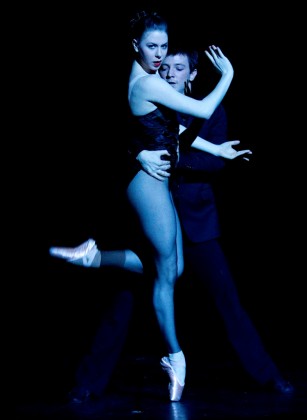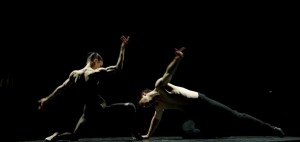WHO NAMED THE DANCERS: La La La Human Steps more structure than meaning
Posted on January 14, 2012 By Mike Ross Front Slider, Music, Theatre
 You think a name like La La La Human Steps would’ve come to its creator in a dream or mystic vision – but no, master choreographer Édouard Lock planned it out as carefully as one of his acclaimed dance routines.
You think a name like La La La Human Steps would’ve come to its creator in a dream or mystic vision – but no, master choreographer Édouard Lock planned it out as carefully as one of his acclaimed dance routines.
Fans can see new work this Wednesday at the Jubilee Auditorium in a piece entitled, um, “New Work” (we’ll get to that one in a moment).
La La La Human Steps, formerly Lock-Danseurs, was christened in 1983.
Lock explains, “It was a reference to language in the sense that what makes a language interesting or in some cases beautiful is not so much the meaning of the words, but in the way the structural elements of the language come together … the movement, certain steps next to others, the phrasing, the rhythm – those things all also define choreography.”
In other words: modern dance – what does it all mean? Who cares? It’s beautiful. That’s the point. French can be beautiful even if you don’t understand French, no?
The “La La La” part came from his mom, Lock says, who used to coo those words to him as a baby, “and I wanted to use that as an allegory,” he says, “referring to the beginning of structured language.” Lock even suggests that the basic “la la la” sound is more of a French thing, leading one to imagine that if the company had formed in Toronto instead of Montreal, its name might be Na Na Na Human Stomps. Doesn’t quite have the same ring to it.
Not even the most cerebral art rock band puts this much thought into its name.
 “Interesting and strange” pretty much sums up how all of Lock’s friends and associates thought of the new name, he recalls – “It was 1983. Everything was interesting and strange” – and he certainly didn’t think at the time he was making some amazing career-changing decision. La La La Human Steps had yet to make a big name for itself, yet to collaborate with people like David Bowie and Frank Zappa, yet to earn its creator a shelf of awards and accolades, including the Order of Canada – all of which Lock laughingly calls “gold stars.” But while La La La Human Steps perfectly illustrates the way he feels about the similarities between choreography and linguistic structure, the “almost flippant” name does not necessarily reflect the work the company does.
“Interesting and strange” pretty much sums up how all of Lock’s friends and associates thought of the new name, he recalls – “It was 1983. Everything was interesting and strange” – and he certainly didn’t think at the time he was making some amazing career-changing decision. La La La Human Steps had yet to make a big name for itself, yet to collaborate with people like David Bowie and Frank Zappa, yet to earn its creator a shelf of awards and accolades, including the Order of Canada – all of which Lock laughingly calls “gold stars.” But while La La La Human Steps perfectly illustrates the way he feels about the similarities between choreography and linguistic structure, the “almost flippant” name does not necessarily reflect the work the company does.
“We’re a serious bunch,” he says.
Then again, he also admits he has a lot of fun playing with an audience’s preconceptions. New Work is named with the “non-name” name because it draws so heavily on two operas (“Dido and Aeneas” by Henry Purcell and “Orpheus and Eurydice” by Christoph Gluck) and to tag them with a fancy new name might be presumptuous. New Work alone is going to challenge, Lock says, “The audience is going to have associations with these operas, they’re going to have resistances, they’re going to say, ‘hey, that’s not what I think it’s about!’ They already have opinions and personal memories. This makes a more interesting dynamic in the theatre.”
Once a name sticks, it ceases to have any meaning beyond the name of the dance company or the art rock band, or whatever. It’s “just our name.” That’s what they all say. But like all good names, La La La Human Steps is not something easily forgotten. It evokes, more or less, what it is – a dance company – and also describes the general philosophy of choreography the choreographer has held for decades. He planned the name carefully, he says, “What I couldn’t plan was the result of it.”











